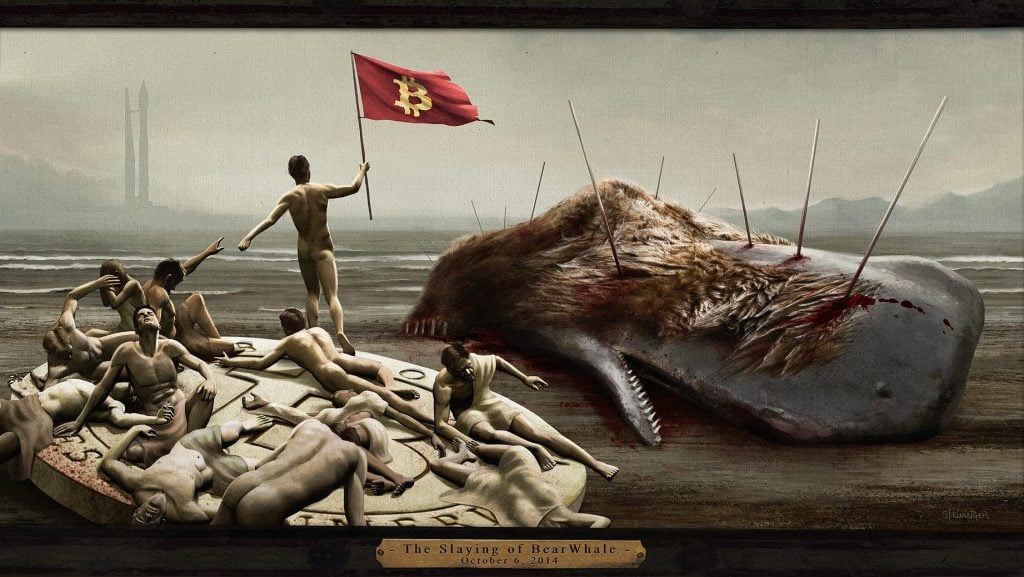Latest news about Bitcoin and all cryptocurrencies. Your daily crypto news habit.

Sometimes when there’s a huge drop in bitcoin’s price traders called “bitcoin whales” are blamed for dumping on the market. Bitcoin whales are individuals or groups who hold vast quantities of bitcoins and can sometimes sway the market towards their preferential price. These market movers have been around since the early days – ‘shaking out weak hands’ many times over the years – but have also failed their missions at times as well.
Also read: Following Money Through the Bitcoin Laundry Is Not So Easy
What is a Bitcoin Whale?
If you trade bitcoins or altcoins, you’ve probably heard the term “whale” before as the name is used to describe big cryptocurrency holders. The term is used this way because whales are the biggest creatures in the ocean and they can overpower smaller fish with their large size. Bitcoin whales are looked at similarly because their extensive holdings can affect large schools of smaller traders with just a few successful trading methods. Additionally the smaller the market and less liquidity means whales can devastate smaller altcoin markets way more easily than bitcoin. We also assume that Satoshi Nakamoto may be the biggest whale of all as the creator allegedly owns 1 million bitcoins.
Rinse and Repeat
 There are many trading maneuvers whales use to profit, like using a trading tactic commonly called the ’rinse and repeat cycle.’ The rinse trade is used in many types of markets and can be effective if timed correctly and very profitable if you are a bitcoin whale. The trader with a lot of holdings starts selling bitcoins lower than the market rate which at times can cause a panic sell off by small-time traders. The trick is the whale sold just below the current market value and just enough to watch panic ensue. Then the whale waits and watches the panic selling take place until the bitcoin price reaches a new low. At this point, the whales quickly scoop up way more bitcoins than they first started with and after the ‘rinse’ they usually ‘repeat’ this type of trade often. People speculate that there are many ways whales can throw their ‘BTC weight’ around to either push the price up or down to accumulate more bitcoins. Further, whales are not just individuals and can be an organization like a bitcoin investment fund as well.
There are many trading maneuvers whales use to profit, like using a trading tactic commonly called the ’rinse and repeat cycle.’ The rinse trade is used in many types of markets and can be effective if timed correctly and very profitable if you are a bitcoin whale. The trader with a lot of holdings starts selling bitcoins lower than the market rate which at times can cause a panic sell off by small-time traders. The trick is the whale sold just below the current market value and just enough to watch panic ensue. Then the whale waits and watches the panic selling take place until the bitcoin price reaches a new low. At this point, the whales quickly scoop up way more bitcoins than they first started with and after the ‘rinse’ they usually ‘repeat’ this type of trade often. People speculate that there are many ways whales can throw their ‘BTC weight’ around to either push the price up or down to accumulate more bitcoins. Further, whales are not just individuals and can be an organization like a bitcoin investment fund as well.
Utilizing Buy and Sell Walls
 Whales in a sense don’t even have to trade their bitcoins to affect the market as they can also bluff with buy and sell walls. In cryptocurrency markets, exchanges use an order book to facilitate trades where a buyer can set up an order to buy or sell at a specified price other than the spot price. For instance, if the market drops traders will usually buy at a lower bid and sell if the price reaches a higher level. In order to place an order in the exchange’s order book, you have to legitimately own enough funds to cover the order. This means a whale and even smaller traders in many ways can bluff and make it seem like a buy or sell walls exist. However, often times large buy and sell walls disappear just before the price gets close enough because a big player was just bluffing. Nevertheless many buy and sell walls are very real and can change the odds rather quickly if they manage to liquidate someone’s assets.
Whales in a sense don’t even have to trade their bitcoins to affect the market as they can also bluff with buy and sell walls. In cryptocurrency markets, exchanges use an order book to facilitate trades where a buyer can set up an order to buy or sell at a specified price other than the spot price. For instance, if the market drops traders will usually buy at a lower bid and sell if the price reaches a higher level. In order to place an order in the exchange’s order book, you have to legitimately own enough funds to cover the order. This means a whale and even smaller traders in many ways can bluff and make it seem like a buy or sell walls exist. However, often times large buy and sell walls disappear just before the price gets close enough because a big player was just bluffing. Nevertheless many buy and sell walls are very real and can change the odds rather quickly if they manage to liquidate someone’s assets.
OTC Markets and Dark Pools
Sometimes whales don’t purchase or sell on traditional exchanges because their holdings or orders could cause a stir in the market. For cryptocurrencies over the counter trading (OTC) or “dark pools” is where big buyers and institutional traders can purchase vast amounts of bitcoins without being seen by the public eye. Dark pools are similar to OTC trading as they are usually found on exchanges that enable ‘off the record’ trades which ensures a whale’s moves are more private. Typically OTC markets and dark pools only allow traders who purchase an abundant amount of bitcoin at one time and set minimums for entry.
The Infamous Bear Whale
Back in October of 2014, there was an event where a massive bitcoin whale liquidated 30,000 bitcoins for $300 a piece. Many traders and speculators thought it would wreck the market at the time but instead, the order was ripped through by buyers and bitcoin’s price subsequently rose to $375. The event was remembered forever, and the trader will forever be known as the “bear whale.” The 30,000 BTC order was also recorded on video alongside many memes and graphics depicting the epic slaying of this gigantic whale. Many bitcoiners felt victorious that day in October because a whale of that size failed to sway the market.
Whales Are Often Blamed for Big Market Shake Outs
Whales have been discussed in the bitcoin space for quite some time, and they are usually blamed for unexplainable market phenomenon. Further, there are a lot of conversations across bitcoin forums asking the question — How many bitcoins does it take to be a whale? It seems the answer varies from 1,000 bitcoins to 10,000 bitcoins according to multiple threads on Bitcointalk.org and Reddit. Many people believe that whales can still affect the market due to bitcoin’s relatively small market capitalization where multi-million dollar orders can still shake things up. As bitcoin markets become stronger and gain more liquidity, speculators believe it now takes bigger bitcoin whales to shift the trading waters.
What do you think about bitcoin whales? Do you think large holders can still sway the market? Let us know what you think in the comments below.
Images via Shutterstock, Pixabay, Bitstamp, and Christopher Steininger.
Can you remember your first-ever bitcoin purchase? For hundreds of us, it was some kind of bitcoin-related swag to show the world we supported the digital economy. Try spending your first bits at our bitcoin.com Store – there’s bitcoin clothing, accessories, art, even bitcoin wallet hardware and research reports. Start your journey down the rabbit hole now.
The post Bitcoin Whales and How They Make Market Waves appeared first on Bitcoin News.
Disclaimer
The views and opinions expressed in this article are solely those of the authors and do not reflect the views of Bitcoin Insider. Every investment and trading move involves risk - this is especially true for cryptocurrencies given their volatility. We strongly advise our readers to conduct their own research when making a decision.
